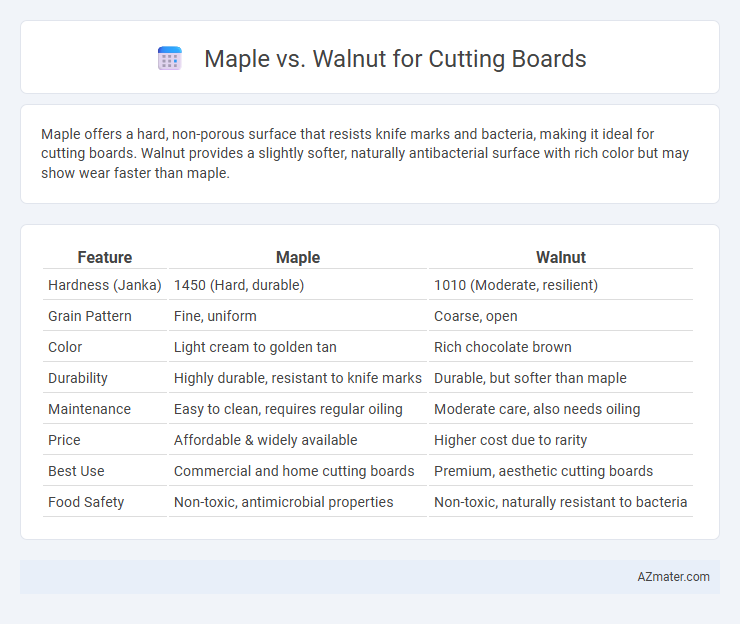Maple offers a hard, non-porous surface that resists knife marks and bacteria, making it ideal for cutting boards. Walnut provides a slightly softer, naturally antibacterial surface with rich color but may show wear faster than maple.
Table of Comparison
| Feature | Maple | Walnut |
|---|---|---|
| Hardness (Janka) | 1450 (Hard, durable) | 1010 (Moderate, resilient) |
| Grain Pattern | Fine, uniform | Coarse, open |
| Color | Light cream to golden tan | Rich chocolate brown |
| Durability | Highly durable, resistant to knife marks | Durable, but softer than maple |
| Maintenance | Easy to clean, requires regular oiling | Moderate care, also needs oiling |
| Price | Affordable & widely available | Higher cost due to rarity |
| Best Use | Commercial and home cutting boards | Premium, aesthetic cutting boards |
| Food Safety | Non-toxic, antimicrobial properties | Non-toxic, naturally resistant to bacteria |
Introduction to Maple and Walnut Cutting Boards
Maple cutting boards are highly favored for their durability and fine, closed grain that resists knife marks and bacterial absorption, making them a hygienic choice for kitchen use. Walnut cutting boards offer a rich, dark color and a slightly softer surface, which is gentle on knives while providing natural antimicrobial properties. Both hardwoods are sustainably sourced and provide an excellent balance of beauty and functionality for food preparation.
Wood Hardness: Maple vs Walnut
Maple, particularly hard rock maple, has a Janka hardness rating around 1,450, making it more resistant to knife marks and dents compared to walnut, which has a softer Janka hardness rating near 1,010. The increased hardness of maple provides superior durability for cutting boards used in heavy chopping tasks, extending the board's lifespan. Walnut's softer texture offers a gentler surface on knives but may show wear and scratches more quickly over time.
Visual Appeal: Color and Grain Patterns
Maple cutting boards feature a light, creamy color with subtle, fine grain patterns that present a clean and uniform look ideal for minimalist kitchens. Walnut cutting boards showcase rich, dark brown hues with striking, varied grain patterns that add warmth and a rustic elegance to any kitchen decor. The choice between Maple and Walnut hinges on whether a bright, understated aesthetic or a deep, dramatic wood tone better complements the kitchen environment.
Durability and Longevity
Maple cutting boards are highly durable due to their dense, fine grain structure, making them resistant to knife marks and warping over time. Walnut offers a slightly softer surface, which is gentler on knives but may show wear more quickly, affecting long-term longevity. Both woods have natural antibacterial properties, but maple's hardness gives it an edge in maintaining durability and lifespan in heavy kitchen use.
Impact on Knife Edges
Maple cutting boards, known for their fine, hard grain, provide a durable surface that minimizes dulling of knife edges, preserving sharpness over time. Walnut boards, featuring a slightly softer and more porous texture, are gentle on blades but may require frequent maintenance to avoid knife edge degradation. Both woods balance hardness and resilience to protect knives, but maple's denser fiber structure offers superior edge retention benefits.
Maintenance and Care Requirements
Maple cutting boards require regular oiling with food-grade mineral oil to prevent drying and cracking, benefiting from their dense, fine grain that resists knife marks and bacteria buildup. Walnut boards also need consistent oiling but are slightly softer, making them more prone to scratches and dents, so frequent conditioning helps maintain their durable, water-resistant surface. Both woods should be hand-washed and dried immediately to avoid warping, with maple offering a bit more resilience in high-moisture environments.
Food Safety Considerations
Maple cutting boards are favored for food safety due to their closed grain structure, which resists moisture and bacteria penetration, making them less prone to harboring harmful pathogens. Walnut, with its slightly more open grain, requires more frequent oiling and maintenance to maintain a hygienic surface and prevent contamination. Both hardwoods are naturally antimicrobial, but proper cleaning and conditioning are essential to ensure food safety regardless of the wood type used.
Price Comparison
Maple cutting boards typically offer a more budget-friendly option, with prices ranging from $20 to $60 depending on size and brand. Walnut boards tend to be more expensive, often starting around $50 and going up to $150 due to their richer color and denser hardwood quality. Choosing maple provides affordable durability while walnut presents a premium investment with a higher price point reflecting its luxury appeal.
Environmental Sustainability
Maple cutting boards offer superior environmental sustainability due to the tree's fast growth rate and widespread availability, which reduces the impact on ecosystems compared to walnut. Walnut trees grow slower and are less abundant, making walnut cutting boards a less eco-friendly choice due to increased deforestation risks and carbon footprint. Choosing sustainably sourced maple ensures a balance between durability and minimizing environmental harm.
Choosing the Best Wood for Your Needs
Maple offers a dense, fine grain that resists scratches and bacteria, making it an ideal choice for durability and hygiene in cutting boards. Walnut provides a softer surface with a rich, dark color that is gentle on knife edges and enhances kitchen aesthetics. Selecting between maple and walnut depends on prioritizing either long-lasting resilience or a softer, visually striking board tailored to your culinary style.

Infographic: Maple vs Walnut for Cutting Board
 azmater.com
azmater.com